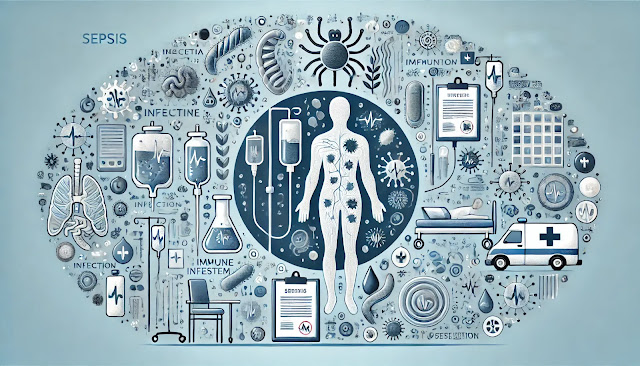Understanding Sepsis: Causes, Symptoms, Diagnosis, and Treatment
1. Definition of Sepsis
Sepsis is a life-threatening condition that arises when the body's response to an infection damages its own tissues and organs. It occurs when chemicals released into the bloodstream to fight an infection trigger widespread inflammation, leading to organ failure or death if not promptly treated.
2. Causes of Sepsis
Sepsis is caused by an infection, which can originate from various sources such as:
- Bacterial infections: These are the most common cause, but viral, fungal, or parasitic infections can also lead to sepsis.
- Lung infections (pneumonia): This can spread to the bloodstream.
- Urinary tract infections: Especially in elderly patients, this is a common source of sepsis.
- Abdominal infections: Such as appendicitis or peritonitis.
- Wound infections: Especially surgical wounds or injuries.
3. Symptoms of Sepsis
Sepsis symptoms can vary depending on the infection's severity but may include:
- High fever or low body temperature: Fluctuations in temperature are a common sign.
- Rapid heart rate: Often accompanied by rapid breathing.
- Confusion or disorientation: Mental changes are common in sepsis patients.
- Chills or shivering: Due to an inflammatory response.
- Severe pain: In the affected area or generalized body pain.
- Shortness of breath: Caused by the body’s inability to maintain oxygen levels.
4. Diagnosis of Sepsis
Sepsis is diagnosed through a combination of physical exams, tests, and patient history:
- Blood tests: These check for infection, organ function, and other markers of sepsis.
- Imaging: X-rays, CT scans, or ultrasounds can help locate the source of infection.
- Urine or wound cultures: These identify the type of infection causing the sepsis.
5. Treatment of Sepsis
Early and aggressive treatment is crucial for improving outcomes in sepsis patients. Treatment involves:
- Antibiotics: Administered as soon as possible to combat the infection.
- IV fluids: To maintain blood pressure and support the body's response to infection.
- Oxygen therapy: In severe cases, oxygen may be administered to help maintain oxygen levels.
- Surgery: To remove the source of infection, such as draining an abscess or removing infected tissue.
6. Prevention of Sepsis
Preventing sepsis involves addressing the risk factors and taking steps to avoid infections:
- Vaccinations: Vaccines for pneumonia, influenza, and other preventable diseases reduce the risk of infection.
- Hygiene practices: Regular handwashing and proper wound care can help prevent infections.
- Chronic condition management: Managing diabetes or other chronic illnesses can reduce infection risk.
- Early treatment of infections: Seek medical care for any signs of infection to prevent it from spreading.
Conclusion
Sepsis is a medical emergency that requires immediate attention. Understanding the causes, symptoms, and treatment options can save lives. By practicing good hygiene, getting vaccinations, and seeking prompt medical care for infections, you can reduce the risk of developing sepsis. This blog provides general information, but please consult a healthcare provider for accurate diagnosis and personalized treatment.




%20where%20a%20person%20stands%20with%20their%20knees%20touching%20while%20their%20feet%20remain%20apart,%20creating%20an%20'X'.png)

.%20The%20image%20should%20depict%20a%20human%20figure%20from%20.webp)

%20in%20a%20medical%20context.%20Show%20symptoms%20like%20constant%20throat%20clearing,%20cough,%20sore%20throat,.webp)
.%20The%20image%20should%20feature%20visual%20representations%20of%20common.webp)
,%20along%20with%20ele.webp)
Comments
Post a Comment